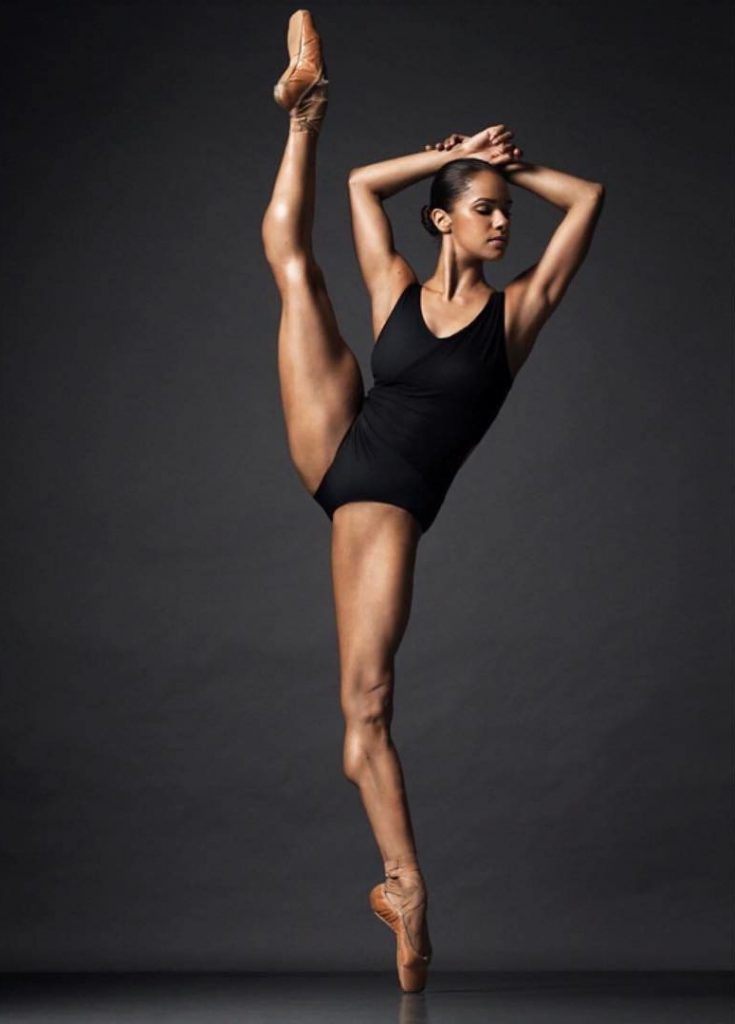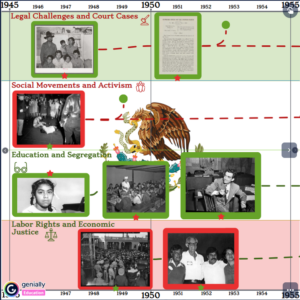“Et un et deux et trois” (and one, and two, and three), are the countless hymns that a typical ballet dancer hears from the rise of dawn to long after sunset. Their long hours in the studio, being constantly on their feet (known as releve), becomes their everyday regime, including exaggerated arm extensions and feet so numb that they do not even feel the blisters from their point shoes; these are examples of the sacrifices and commitments that young ballet dancers experience to make the top one percent that become professionals. An aspiring young African-American woman named Misty Copeland was born to break all barriers in the dance world and change the image of what a ballerina should look like. Misty grew up in a household of five siblings, to a mother of multiple marriages, and to a father who was nearly absent from her life for twenty years; she became American Ballet Theater’s first African-American ballet dancer.1 She is world renowned for her acclaimed performances and the statuesque perfection that has made her an elite dancer. Growing up, she never realized her potential, because of her constant fight for her mother’s attention among her other siblings. Copeland soon realized her passion for dance when she performed dance routines at home to a Mariah Carey chart topper. With no formal ballet or gymnastics experience, she tried out for her middle school drill team, following in her older sister’s footsteps; the elite dance team was recognized for winning countless statewide competitions.2

Even though Misty’s frame was regarded as petite, at thirteen years old Misty was able to use her assertiveness that she gained at home to become captain of the drill team. She was praised for her natural grace and finesse on the dance floor, which later came to the attention of her classically trained coach, Elizabeth Cantine. Off the dance floor, Copeland struggled with the difficulties that her family was enduring. In the year 1994, after her mother’s various friends and boyfriends, her family moved into a small two bedroom Inn in Gardena, California. Along with her brothers and sisters, Misty slept on the floor with only blankets. She regards this memory as, “The hardest time in my childhood,” saying that she made up for the chaos at home by working doubly hard at school.3
Misty’s dance career began at a later age than that of most elite dancers; the average dancer begins training between the ages of four and eight, but her formal training did not begin until age thirteen. Copeland’s middle school drill team coach encouraged her to attend the Boys and Girls Club, where a ballet instructor, Cynthia Bradley, taught free ballet classes once a week. Misty originally declined the offer because her mother did not have a car, and was working twelve to fourteen hours a day, and her oldest sister Erica was working two jobs. But Instructor Bradley began picking Misty up from school. Copeland was able to demonstrate how others’ preconceptions can be disproved with raw talent, “You can start late, look different, be uncertain, and still succeed.”4 Within her brief three months of training with Bradley, Copeland had mastered the French technique of en pointe, which signifies standing on the tip of your toes in ballet shoes, something that takes most ballerinas years to master. As her training became more intensive, Misty began spending most of her hours at the studio, which angered her mother, who told her that she would have to give up ballet. However, Bradley saw a spark of passion in Misty, and offered to host her during her training, as many trainers do for professional athletes. Her mother concluded that it was the best option, considering that their home life was unstable. Copeland explained that the feel of slippers and leotards gave her a sense of confidence and empowerment; she felt like she finally fit in. She had a place to call home and a sport to idolize: “Ballet was so structured. I’d been craving something that could guide me.”5 In the year 1998, at the age of fifteen, she won first prize in the ballet category of the Los Angeles Music Center Spotlight Awards.6

However, that same year a custody battle ensued between the Bradleys and Copeland’s mother. Misty had to return home to her mother, and they had frequent arguments. Her mother had long resented the Bradleys’ influence of homeschooling, Christian religion, and far more personal attention with Misty, and ultimately she decided that Misty would have to cease her continuation with the Bradleys. Misty was distraught with the fear that she would not be able to continue her dance career. The Bradleys then helped Misty to emancipate herself, which was a procedure common among young performers for securing their financial and residential independence. After Misty’s mother received the emancipation documents, she hired famous feminist attorney Gloria Allred and applied a series of restraining orders, which included the Bradleys’ five-year-old son. The order was partly intended to preclude contact between the Bradleys and Misty, but it did not have proper legal basis, since there had been no stalking or harassment.7 The custody controversy was highly publicized in the press: “The attention was devastating,” she says. “I had been so private. It was scarring.”8 After Misty’s mother stated that she would make sure Copeland could dance, both emancipation papers and restraining orders were dropped.
Copeland then began attending San Pedro High School, and continued to study at Lauridsen Ballet Centre in Torrance, California. In 2000, Copeland won another full scholarship, this time to American Ballet Theater’s intensive summer program; and soon after, she became the only African-American woman in a group of eighty dancers. Though she was challenged by her difference, not only her skin color but also her body type, always more full figured than her peers, she nevertheless climbed the ranks by virtue of her exceptional skill.9 In 2007, she became the company’s first African-American female soloist in two decades, with notable performances in The Firebird (2012), in Le Corsaire (2013), and in Swan Lake (2014), to name a few. Copeland’s inspiring story made her a role model and pop icon. She is a New York Times Bestseller in Ballerina Body, a memoir Life in Motion, and Firebird, an inspiring children’s book that shows that through hard work and dedication any young dancer can become a Firebird.10 “I had moments of doubting myself, and wanting to quit, because I didn’t know that there would be a future for an African-American woman to make it to this level. At the same time, it made me so hungry to push through to carry the next generation. So it’s not me up here and I’m constantly saying that it’s everyone that came before me that got me to this position.”11
- Encyclopedia Britannica, 2016, s.v. “Internet,” by Naomi Blumburg. https://www.britannica.com/biography/Misty-Copeland (accessed February 18, 2018). ↵
- Kristen Mascia, “Misty Copeland on Love, Life, and Leaps of Faith,” Elle Magazine, May 29, 2014, 1. ↵
- Kristen Mascia, “Misty Copeland on Love, Life, and Leaps of Faith,” Elle Magazine, May 29, 2014, 1. ↵
- Misty Copeland, Life in Motion (New York: Scholastic Inc, 2017), 262. ↵
- Kristen Mascia, “Misty Copeland on Love, Life, and Leaps of Faith,” Elle Magazine, May 29, 2014, 1. ↵
- Encyclopedia Britannica, 2016, s.v. “Internet,” by Naomi Blumburg. https://www.britannica.com/biography/Misty-Copeland (accessed February 18, 2018). ↵
- Misty Copeland, Life in Motion (New York: Scholastic Inc, 2017), 263. ↵
- Kristen Mascia, “Misty Copeland on Love, Life, and Leaps of Faith,” Elle Magazine, May 29, 2014, 1. ↵
- Encyclopedia Britannica, 2016, s.v. “Internet,” by Naomi Blumburg. https://www.britannica.com/biography/Misty-Copeland (accessed February 18, 2018). ↵
- Macey Morales, “Acclaimed Author, Ballerina Misty Copeland to serve as 2018 National Library Week Honorary Chair,” American Library Association. December 5, 2017, http://www.ala.org/news/press-releases/2017/12/acclaimed-author-ballerina-misty-copeland-serve-2018-national-library-week. (accessed February 18, 2018). ↵
- The Biography.com website, Misty Copeland Biography, https://www.biography.com/people/misty-copeland (accessed February 18, 2018). ↵



87 comments
Miguel Camarillo-Cohen
Great article. Another inspiring story about how one African American woman broke the glass ceiling in her pursuit to master her craft to become a ballerina. In 2007, Misty became the first African-American ballerina soloist in over 20 years. Among her many stunning performances were The Firebird (2012), Le Corsaire (2013), and Swan Lake (2014). The photos that were included are spectacular.
Lewis Wilson
This is a very interesting article and I had never heard of the issue before. Misty seems like an amazing person and I found it hard to believe that it took so long for a black woman to become a famous ballet dancer. She is an inspiration for all! This article was very well written and it deserves to be nominated for the awards that it is.
Irene Astran
You did a great job of framing Copeland’s perseverance. It is sad that her mother attempted to hinder her progress in dance. How incredible that the Bradleys would so far to help her escape a dark past. I appreciate the pictures that you have in this article. They are so beautiful. It would have been nice to put faces to names with pictures if her mother and the Bradleys if you were able to locate them.
Didier Cadena
I was unaware about who Misty Copeland was, but I am glad to be able to actually be able to read a little about her. I was unaware of how much dedication goes into ballet and how hard it actually is. It was amazing to be able to find out about her success and how much of a role model she is. The article does a great job of putting all the information together and still make it interesting to read.
Vanessa Tombo
I remember reading about Misty Copeland in the newspaper not too long ago. I skimmed through the newspaper but this article provided me with more facts than the newspaper had. Being a woman, of African American status, who is revolutionizing the face of ballet. Is not a story you hear every day. She introducing young girls into a world they might have thought they did not belong in. Copeland has become a role model to all who know her journey.
Isaac Saenz
Misty Copeland’s story is one of true inspiration. Coming from a very troubled home and an unstable family, Misty was able to use ballet as a distraction, growing a passion for it in the process. Her raw talent allowed her to dance at a competitive level despite her lack of experience. Her coach even offered to host her just so that she could continue training and become the success that she was destined to be.
Matthew Wyatt
I’d heard of Misty Copeland before, but never really knew anything about her before reading this article. Clearly she is an amazing woman who broke barriers I wasn’t even fully aware of. It’s incredible to think that it took until the year 2000 for an African-American woman to really make a name for herself in the ballet scene. I do recommend placing some sort of lead-in statement before the final quote explaining where it came from. This will clear up any confusion, especially since you had just finished listing off several books she had written.
Kailan Pena
Misty Copeland was a role model for many ballerinas that have had their own fair share of struggle in getting a shot in their profession. Despite her rough childhood and no support from her mother she still managed to seek her full potential as a ballerina and break barriers that were keeping her from success. She knew what she was capable of and she made it happen.
Alexandra Cantu
Congratulations on being nominated for Best use of images. Your use of images allows the reader to full comprehend how great Misty Copeland really is. Misty Copeland is a role mode for many individuals especially dancers of color. You can tell that the author did extensive research about Copeland to provide the lawsuit between her mom and Misty Copeland dance teacher. Good Luck!
Erin Vento
I love the pictures in this article! I feel like dance is a sport that really overlooked as a sport, but the photos really show her strength and how effortless she makes it look. I love how the article itself really focuses on the all the things she had to overcome in order to be where she is today. It really shows how iconic Misty is.